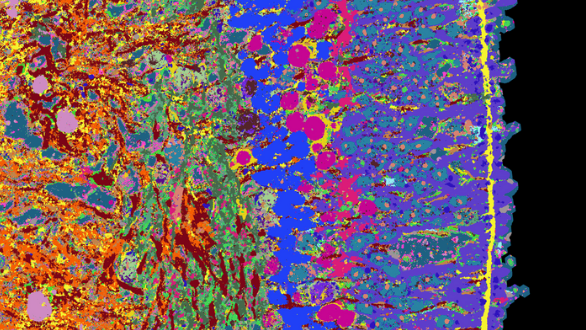Article
Development of human retina detailed in high-resolution atlas
Author(s):
A team of researchers has now developed an approach to gather and compile a great deal of information about organoids and their development. The team applied its approach to the organoids of the human retina, which they derived from stem cells.
The detail of a cross-section of a retinal organoid. Different tissue structures are made visible with different colors. (Image courtesy of Wahle et.al/Nature Biology)

Researchers are creating a specialized atlas that may unlock key questions, including what cell types are found in which human tissue, and where? Which genes are active in the individual cells, and which proteins are found there?
The researchers also hope to determine how the different tissues form during embryonic development and what causes diseases.
According to a news release from ETH Zurich, in creating this atlas, researchers aim to map not only tissue directly isolated from humans, but also structures called organoids. These are 3D clumps of tissue that are cultivated in the laboratory and develop in a way similar to human organs, but on a small scale.
“The advantage of organoids is that we can intervene in their development and test active substances on them, which allows us to learn more about healthy tissue as well as diseases,” Barbara Treutlein, a professor of Quantitative Developmental Biology at the Department of Biosystems Science and Engineering at ETH Zurich in Basel, said in the news release.
In an effort to produce such an atlas, Treutlein teamed up with researchers from the Universities of Zurich and Basel, has now developed an approach to gather and compile a great deal of information about organoids and their development. The research team applied this approach to the organoids of the human retina, which they derived from stem cells.
Many proteins visible simultaneously
The key methods the scientists used for their approach was the 4i technology: iterative indirect immunofluorescence imaging. The explained in the release the new imaging technique can visualize several dozen proteins in a thin tissue section at high resolution using fluorescence microscopy. The 4i technology was developed a few years ago by Lucas Pelkmans, a professor at the University of Zurich and coauthor of the study.1
Typically, researchers use fluorescence microscopy to highlight three proteins in a tissue, each with a different fluorescent dye.
Technical reasons prevent scientists from staining more than 5 proteins at a time. In 4i technology, 3 dyes are used, but these are washed from the tissue sample after measurements have been taken, and 3 new proteins are stained. This step was performed 18 times, by a robot, and the process took a total of 18 days. Lastly, a computer merges the individual images into a single microscopy image on which 53 different proteins are visible. They provide information on the function of the individual cell types that make up the retina; for example, rods, cones, and ganglion cells.
The researchers have supplemented this visual information of retinal proteins with information on which genes are read in the individual cells.
High spatial and temporal resolution
According to ETH Zurich, the scientists performed all these analyses on organoids that were of different ages and thus at different stages of development. In this way, they were able to create a time series of images and genetic information that describes the entire 39-week development of retinal organoids.
“We can use this time series to show how the organoid tissue slowly builds up, where which cell types proliferate and when, and where the synapses are located. The processes are comparable to those of retinal formation during embryonic development,” Gray Camp, a professor at the University of Basel and a senior author of this study, said in the release.
Further tissue types planned
ETH Zurich also noted that to date, the scientists have been studying how a healthy retina develops, but in the future, they hope to deliberately disrupt development in retinal organoids with drugs or genetic modifications.
“This will give us new insights into diseases such as retinitis pigmentosa, a hereditary condition that causes the retina’s light-sensitive receptors to gradually degenerate and ultimately leads to blindness,” Camp explained in the news release.
Moreover, the researchers want to find out when this process begins and how it can be stopped.
Treutlein and her colleagues are also working on applying the new detailed mapping approach to other tissue types, such as different sections of the human brain and to various tumor tissues. Step by step, this will create an atlas that provides information on the development of human organoids and tissues.
Reference
Wahle P, Brancati G, Harmel C, He Z et al.: Multimodal spatiotemporal phenotyping of human retinal organoid development. Nature Biotechnology, 8 May 2023, doi: 10.1038/s41587-023-01747-2





